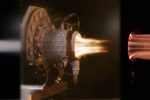3DPRINTINGINDUSTRY.COM
LEAP 71 Advances in Rocket Engine Program, Developing Meganewton-Class Propulsion Systems
LEAP 71, a Dubai-based engineering company, has entered a new phase in its rocket engine program, concentrating on developing meganewton-class propulsion systems. This effort includes two key engine designs: a 200 kN aerospike and a 2000 kN bell-nozzle, both built upon previous work with smaller-scale engines. The company is using computational engineering techniques and industrial-scale 3D printing to create complex propulsion systems tailored for future space missions.
“The aerospike and bell-nozzle engines we’re creating are not independent efforts—they’re different expressions of the same computational DNA,” explained Josefine Lissner, Managing Director of LEAP 71. “This cohesive approach enables us to explore distinct engine architectures without reinventing the wheel each time. It’s a systematic process for scaling complexity.”
LEAP71 fires an advanced Aerospike rocket engine. Photo via LEAP71.
LEAP 71’s Integration of Computational Engineering and Additive Manufacturing
The new propulsion systems are designed as fully integrated propulsion solutions. The company highlighted its advancements in large-format metal Additive Manufacturing, capable of printing parts exceeding 1.5 meters in size. This technology enables the direct production of full-scale, high-thrust engine components, while also reducing part counts, eliminating the need for complex assemblies, and simplifying precision and post-processing requirements.
A previous demonstration—featuring a 5 kN aerospike engine created from a single copper piece—demonstrated the potential of this approach. Current designs build upon this concept, incorporating components such as the 600 mm injector head of the XRB-2E6 and its sea-level nozzle, which require a build height of approximately 1.6 meters.
Detailed model of a rocket engine. Photo via LEAP71.
Despite the progress, Lin Kayser, Co-Founder of LEAP 71, highlighted the practical challenges of turning digital models into working hardware. “The toughest challenge remains translating computational models into real, testable hardware,” said Kayser. “Especially in turbomachinery, where sealing, material fatigue, and transient conditions during startup and shutdown are critical. These aren’t just design issues—they require practical testing, iteration, and close collaboration with manufacturing partners.”
The program follows a structured, multi-year roadmap, starting with simpler configurations like gas generator cycles to establish a solid technical foundation. The first test campaign for the XRA-2E5 aerospike engine is set to take place within 18 months. The more advanced XRB-2E6 bell-nozzle engine, featuring a full-flow staged combustion cycle, is expected to reach readiness by 2029.
“This is a long journey, but the pace at which we’re advancing with computational engineering and modern manufacturing tools is promising,” Lissner said. “We believe this approach has the potential to revolutionize the way propulsion systems are designed and produced.”
As the program progresses, LEAP 71 is working closely with Additive Manufacturing partners to qualify full-scale production processes. The company is also collaborating with aerospace clients to adapt its reference designs into flight-ready propulsion systems for orbital missions.
3D Printed Space Rockets
In 2023, Australian heat transfer specialist Conflux Technology partnered with German space rocket manufacturer Rocket Factory Augsburg (RFA) to embed their 3D printed heat exchanger into an orbital rocket. Part of the Australian Space Agency’s Moon to Mars initiative, the heat exchanger components are 3D printed using Conflux Technology’s Monel K 500 metal alloy material and EOS M300-4 Direct Metal Laser Sintering (DMLS) 3D printers.
Elsewhere, Relativity Space launched the world’s first 3D printed rocket, the Terran 1, marking a significant step forward for additive manufacturing’s role within the space industry. After launching from Cape Canaveral Space Force Station in Florida the rocket, 85% of which is 3D printed, ultimately failed to reach orbit. Yet, the Terran 1 launch was heralded as a success by Relative Space, which intends to increase the 3D printed mass of future vehicles to 95%.
Who won the 2024 3D Printing Industry Awards?
Subscribe to the 3D Printing Industry newsletter to keep up with the latest 3D printing news.
You can also follow us on LinkedIn, and subscribe to the 3D Printing Industry Youtube channel to access more exclusive content.Featured image LEAP71 fires an advanced Aerospike rocket engine. Photo via LEAP71.
Paloma Duran
Paloma Duran holds a BA in International Relations and an MA in Journalism. Specializing in writing, podcasting, and content and event creation, she works across politics, energy, mining, and technology. With a passion for global trends, Paloma is particularly interested in the impact of technology like 3D printing on shaping our future.
